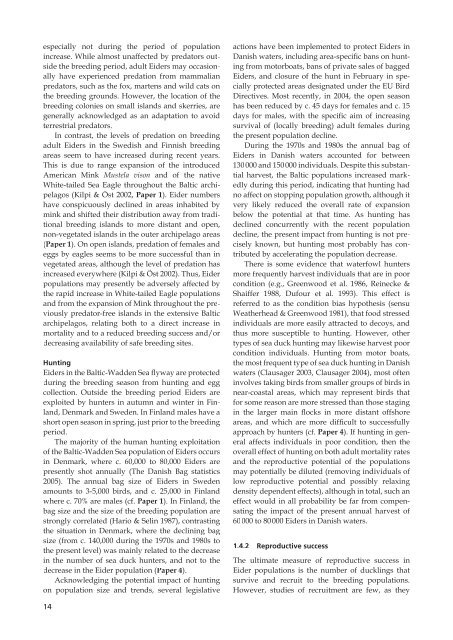Factors affecting population size of Baltic Common Eiders Somateria ...
Factors affecting population size of Baltic Common Eiders Somateria ...
Factors affecting population size of Baltic Common Eiders Somateria ...
Create successful ePaper yourself
Turn your PDF publications into a flip-book with our unique Google optimized e-Paper software.
especially not during the period <strong>of</strong> <strong>population</strong><br />
increase. While almost unaffected by predators outside<br />
the breeding period, adult <strong>Eiders</strong> may occasionally<br />
have experienced predation from mammalian<br />
predators, such as the fox, martens and wild cats on<br />
the breeding grounds. However, the location <strong>of</strong> the<br />
breeding colonies on small islands and skerries, are<br />
generally acknowledged as an adaptation to avoid<br />
terrestrial predators.<br />
In contrast, the levels <strong>of</strong> predation on breeding<br />
adult <strong>Eiders</strong> in the Swedish and Finnish breeding<br />
areas seem to have increased during recent years.<br />
This is due to range expansion <strong>of</strong> the introduced<br />
American Mink Mustela vison and <strong>of</strong> the native<br />
White-tailed Sea Eagle throughout the <strong>Baltic</strong> archipelagos<br />
(Kilpi & Öst 2002, Paper 1). Eider numbers<br />
have conspicuously declined in areas inhabited by<br />
mink and shifted their distribution away from traditional<br />
breeding islands to more distant and open,<br />
non-vegetated islands in the outer archipelago areas<br />
(Paper 1). On open islands, predation <strong>of</strong> females and<br />
eggs by eagles seems to be more successful than in<br />
vegetated areas, although the level <strong>of</strong> predation has<br />
increased everywhere (Kilpi & Öst 2002). Thus, Eider<br />
<strong>population</strong>s may presently be adversely affected by<br />
the rapid increase in White-tailed Eagle <strong>population</strong>s<br />
and from the expansion <strong>of</strong> Mink throughout the previously<br />
predator-free islands in the extensive <strong>Baltic</strong><br />
archipelagos, relating both to a direct increase in<br />
mortality and to a reduced breeding success and/or<br />
decreasing availability <strong>of</strong> safe breeding sites.<br />
Hunting<br />
<strong>Eiders</strong> in the <strong>Baltic</strong>-Wadden Sea flyway are protected<br />
during the breeding season from hunting and egg<br />
collection. Outside the breeding period <strong>Eiders</strong> are<br />
exploited by hunters in autumn and winter in Finland,<br />
Denmark and Sweden. In Finland males have a<br />
short open season in spring, just prior to the breeding<br />
period.<br />
The majority <strong>of</strong> the human hunting exploitation<br />
<strong>of</strong> the <strong>Baltic</strong>-Wadden Sea <strong>population</strong> <strong>of</strong> <strong>Eiders</strong> occurs<br />
in Denmark, where c. 60,000 to 80,000 <strong>Eiders</strong> are<br />
presently shot annually (The Danish Bag statistics<br />
2005). The annual bag <strong>size</strong> <strong>of</strong> <strong>Eiders</strong> in Sweden<br />
amounts to 3-5,000 birds, and c. 25,000 in Finland<br />
where c. 70% are males (cf. Paper 1). In Finland, the<br />
bag <strong>size</strong> and the <strong>size</strong> <strong>of</strong> the breeding <strong>population</strong> are<br />
strongly correlated (Hario & Selin 1987), contrasting<br />
the situation in Denmark, where the declining bag<br />
<strong>size</strong> (from c. 140,000 during the 1970s and 1980s to<br />
the present level) was mainly related to the decrease<br />
in the number <strong>of</strong> sea duck hunters, and not to the<br />
decrease in the Eider <strong>population</strong> (Paper 4).<br />
Acknowledging the potential impact <strong>of</strong> hunting<br />
on <strong>population</strong> <strong>size</strong> and trends, several legislative<br />
14<br />
actions have been implemented to protect <strong>Eiders</strong> in<br />
Danish waters, including area-specific bans on hunting<br />
from motorboats, bans <strong>of</strong> private sales <strong>of</strong> bagged<br />
<strong>Eiders</strong>, and closure <strong>of</strong> the hunt in February in specially<br />
protected areas designated under the EU Bird<br />
Directives. Most recently, in 2004, the open season<br />
has been reduced by c. 45 days for females and c. 15<br />
days for males, with the specific aim <strong>of</strong> increasing<br />
survival <strong>of</strong> (locally breeding) adult females during<br />
the present <strong>population</strong> decline.<br />
During the 1970s and 1980s the annual bag <strong>of</strong><br />
<strong>Eiders</strong> in Danish waters accounted for between<br />
130000 and 150 000 individuals. Despite this substantial<br />
harvest, the <strong>Baltic</strong> <strong>population</strong>s increased markedly<br />
during this period, indicating that hunting had<br />
no affect on stopping <strong>population</strong> growth, although it<br />
very likely reduced the overall rate <strong>of</strong> expansion<br />
below the potential at that time. As hunting has<br />
declined concurrently with the recent <strong>population</strong><br />
decline, the present impact from hunting is not precisely<br />
known, but hunting most probably has contributed<br />
by accelerating the <strong>population</strong> decrease.<br />
There is some evidence that waterfowl hunters<br />
more frequently harvest individuals that are in poor<br />
condition (e.g., Greenwood et al. 1986, Reinecke &<br />
Shaiffer 1988, Dufour et al. 1993). This effect is<br />
referred to as the condition bias hypothesis (sensu<br />
Weatherhead & Greenwood 1981), that food stressed<br />
individuals are more easily attracted to decoys, and<br />
thus more susceptible to hunting. However, other<br />
types <strong>of</strong> sea duck hunting may likewise harvest poor<br />
condition individuals. Hunting from motor boats,<br />
the most frequent type <strong>of</strong> sea duck hunting in Danish<br />
waters (Clausager 2003, Clausager 2004), most <strong>of</strong>ten<br />
involves taking birds from smaller groups <strong>of</strong> birds in<br />
near-coastal areas, which may represent birds that<br />
for some reason are more stressed than those staging<br />
in the larger main flocks in more distant <strong>of</strong>fshore<br />
areas, and which are more difficult to successfully<br />
approach by hunters (cf. Paper 4). If hunting in general<br />
affects individuals in poor condition, then the<br />
overall effect <strong>of</strong> hunting on both adult mortality rates<br />
and the reproductive potential <strong>of</strong> the <strong>population</strong>s<br />
may potentially be diluted (removing individuals <strong>of</strong><br />
low reproductive potential and possibly relaxing<br />
density dependent effects), although in total, such an<br />
effect would in all probability be far from compensating<br />
the impact <strong>of</strong> the present annual harvest <strong>of</strong><br />
60000 to 80000 <strong>Eiders</strong> in Danish waters.<br />
1.4.2 Reproductive success<br />
The ultimate measure <strong>of</strong> reproductive success in<br />
Eider <strong>population</strong>s is the number <strong>of</strong> ducklings that<br />
survive and recruit to the breeding <strong>population</strong>s.<br />
However, studies <strong>of</strong> recruitment are few, as they

















